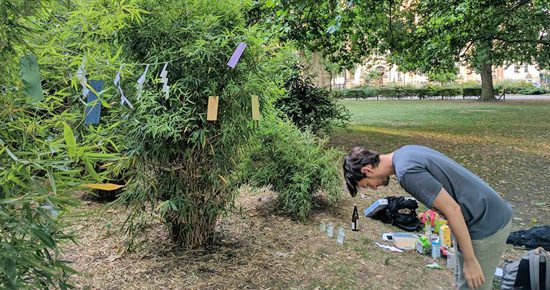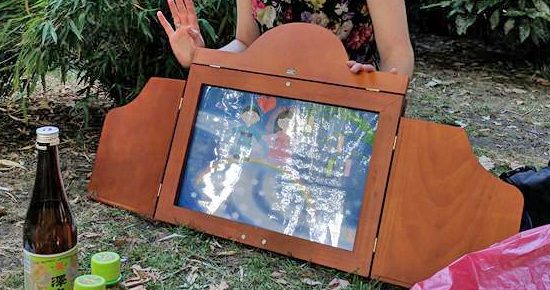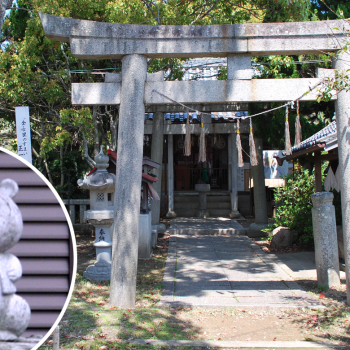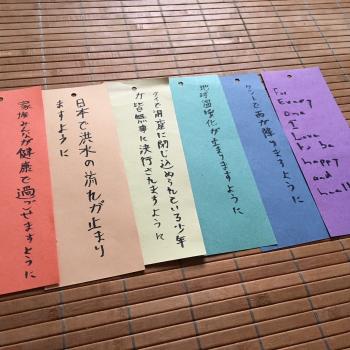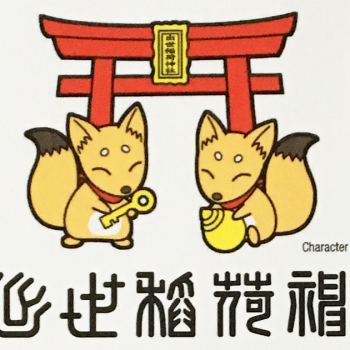July 7th is Tanabata, the Japanese “Star Festival” celebrating the reunion of the astral lovers Orihime (Vega) and Hikoboshi (Altair). And on Friday, members of Shinto In The UK gathered at Lincoln’s Inn Fields park in central London to commemorate the festival with an evening of Shinto and Japanese cultural activities.
Nestled within the park is a small grove of bamboo, and this is where we gathered for our celebrations.
We began by making shide. Shide are paper strips, folded into zigzags looking like lightening bolts. Shide are used to represent sacred spaces and the presence of kami. Shide are usually attached to straw ropes, called shimenawa. Shide are fairly simple to make; you can see how to make one here.
After making the shide, we attached them to some biodegradable string (the type used in horticulture), and tied this makeshift shimenawa to two of the bamboo – forming something similar to a shime-style torii. This we used as a temporary shrine.
After this, we held the most famous Tanabata tradition: making tanzaku. Tanzaku are coloured strips of paper upon which you write a wish. You then hang the tanzaku on bamboo, and the wind carries the wishes up into the heavens where, if you’re lucky, the gods will listen to them and grant them.
After hanging our wishes, we held a small ritual. I placed an offering of sake on the ground by the bamboo, and then we prayed before the shimenawa in the Shinto way (we bowed twice, clapped our hands twice, made a silent prayer and bowed again).
I poured a little sake at the base of each tree, and then we shared the sake with each other, passing round the cup. This is more of a Neopagan tradition than a Shinto one. It’s often the case that where rituals that are 100% Shinto not feasible to perform (which is almost always the case in the UK), adding Pagan-style elements as a substitute really works well.
 Following this, it was starting to get dark; a perfect time to begin playing a modified version of the Japanese game hyaku-monogatari. Meaning “one hundred stories,” hyaku-monogatari is a way of telling ghost stories. Traditionally, you light one hundred candles and tell one hundred ghost stories, blowing out a candle each time you tell a story. Once you tell the final story and blow out the last candle, a ghost is supposed to appear. Why did we play this game? Because in Japan, ghosts are associated with summer, rather than autumn as they tend to be in the west.
Following this, it was starting to get dark; a perfect time to begin playing a modified version of the Japanese game hyaku-monogatari. Meaning “one hundred stories,” hyaku-monogatari is a way of telling ghost stories. Traditionally, you light one hundred candles and tell one hundred ghost stories, blowing out a candle each time you tell a story. Once you tell the final story and blow out the last candle, a ghost is supposed to appear. Why did we play this game? Because in Japan, ghosts are associated with summer, rather than autumn as they tend to be in the west.
We were only a small group, so there was no way we could tell one hundred stories. But we did light some candles and tell a story each. There were traditional Japanese ghost stories, original modern ghost stories, and stories taken from real life experiences. I didn’t actually tell a ghost story; instead I told the story of Tanabata using kami-shibai. Meaning “paper stage,” kami-shibai is a traditional method of telling stories through pictures, which are slotted into a wooden frame.
Needless to say, a ghost didn’t appear! But it was still quite fun and launched lots of interesting talk about ghosts, alien abductions, and other supernatural experiences.
Once we had all finished, we removed the shimenawa and the tanzaku from the bamboo (it could potentially be harmful to the bamboo and any other wildlife.
This is the first time members of Shinto In The UK have come together for a Shinto celebration, and it was a wonderful, friendly, spiritual occasion. We were particularly lucky to have Taishi Kato, our resident Shinto priest, with us to provide guidance and advice in our practises. Sadly, Taishi will be returning to Japan in the autumn – we hope we can continue the growing enthusiasm and interest in Shinto that he’s started since coming to the UK!
If you would like to participate in Shinto activities in the UK, please do join the Shinto In The UK Facebook page.

